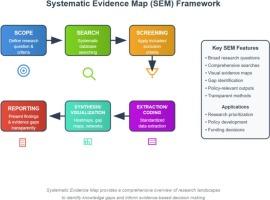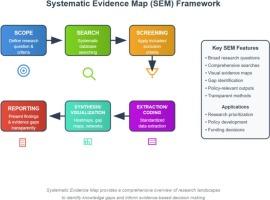Guidance to undertaking systematic evidence maps
IF 9.7
1区 环境科学与生态学
Q1 ENVIRONMENTAL SCIENCES
引用次数: 0
Abstract
Systematic Evidence Maps (SEMs) are a form of evidence synthesis offering structured approaches to categorizing and organizing scientific evidence by identifying trends and gaps. SEMs support researchers and policymakers in navigating complex evidence landscapes. By synthesizing evidence, they lay the foundation for targeted systematic reviews and primary research, supporting evidence-informed decision-making. These outputs can be hosted on websites, providing an interactive tool. In environmental health, SEMs are systematically used to categorize evidence on topics such as pollution control measures, climate change impacts, and health disparities. The methodological framework for conducting SEMs involves defining the research scope, employing a systematic search strategy, screening studies systematically, optionally conducting critical appraisal (risk of bias assessment) when studies are categorized by effect direction or intended to inform subsequent syntheses, and coding data for synthesis and visualization. Narrative synthesis, heatmaps and network diagrams enhance SEMs usability. However, challenges remain, including methodological inconsistencies and the need for standardization. Advances in automation, machine learning, and stakeholder engagement can further refine SEMs methodologies. This commentary situates SEMs within the broader family of evidence synthesis, emphasizing their role in environmental health science. By enhancing methodological clarity and leveraging innovative tools, SEMs can support researchers and decision-makers in navigating complex evidence ecosystems and implementing evidence-based solutions for environmental scientists.


开展系统证据地图的指导
系统证据图(SEMs)是一种证据综合形式,通过确定趋势和差距,为分类和组织科学证据提供结构化方法。中小企业支持研究人员和政策制定者驾驭复杂的证据格局。通过综合证据,它们为有针对性的系统评价和初步研究奠定了基础,支持循证决策。这些输出可以放在网站上,提供一个互动工具。在环境卫生领域,sem被系统地用于对污染控制措施、气候变化影响和健康差异等主题的证据进行分类。进行sem的方法学框架包括定义研究范围,采用系统的搜索策略,系统地筛选研究,当研究按效果方向分类或旨在为后续综合提供信息时,可选地进行关键评估(偏见风险评估),以及为综合和可视化编码数据。叙述综合、热图、网络图和证据差距图增强了SEM的可用性。然而,挑战仍然存在,包括方法上的不一致和标准化的需要。自动化、机器学习和利益相关者参与的进步可以进一步完善SEM方法。本评论将中小企业置于更广泛的证据综合家族中,强调它们在环境健康科学中的作用。通过提高方法清晰度和利用创新工具,中小企业可以支持研究人员和决策者驾驭复杂的证据生态系统,并为环境科学家实施基于证据的解决方案。
本文章由计算机程序翻译,如有差异,请以英文原文为准。
求助全文
约1分钟内获得全文
求助全文
来源期刊

Environment International
环境科学-环境科学
CiteScore
21.90
自引率
3.40%
发文量
734
审稿时长
2.8 months
期刊介绍:
Environmental Health publishes manuscripts focusing on critical aspects of environmental and occupational medicine, including studies in toxicology and epidemiology, to illuminate the human health implications of exposure to environmental hazards. The journal adopts an open-access model and practices open peer review.
It caters to scientists and practitioners across all environmental science domains, directly or indirectly impacting human health and well-being. With a commitment to enhancing the prevention of environmentally-related health risks, Environmental Health serves as a public health journal for the community and scientists engaged in matters of public health significance concerning the environment.
 求助内容:
求助内容: 应助结果提醒方式:
应助结果提醒方式:


